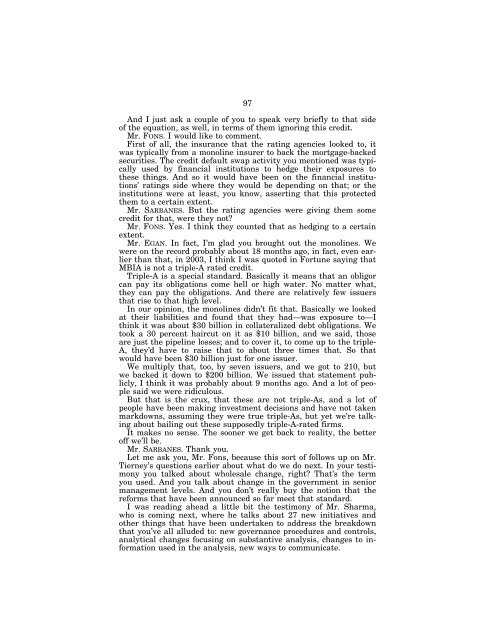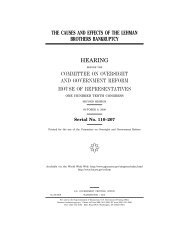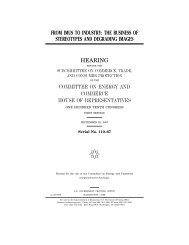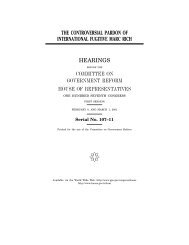CREDIT RATING AGENCIES AND THE FINANCIAL CRISIS ...
CREDIT RATING AGENCIES AND THE FINANCIAL CRISIS ...
CREDIT RATING AGENCIES AND THE FINANCIAL CRISIS ...
- No tags were found...
You also want an ePaper? Increase the reach of your titles
YUMPU automatically turns print PDFs into web optimized ePapers that Google loves.
97And I just ask a couple of you to speak very briefly to that sideof the equation, as well, in terms of them ignoring this credit.Mr. FONS. I would like to comment.First of all, the insurance that the rating agencies looked to, itwas typically from a monoline insurer to back the mortgage-backedsecurities. The credit default swap activity you mentioned was typicallyused by financial institutions to hedge their exposures tothese things. And so it would have been on the financial institutions’ratings side where they would be depending on that; or theinstitutions were at least, you know, asserting that this protectedthem to a certain extent.Mr. SARBANES. But the rating agencies were giving them somecredit for that, were they not?Mr. FONS. Yes. I think they counted that as hedging to a certainextent.Mr. EGAN. In fact, I’m glad you brought out the monolines. Wewere on the record probably about 18 months ago, in fact, even earlierthan that, in 2003, I think I was quoted in Fortune saying thatMBIA is not a triple-A rated credit.Triple-A is a special standard. Basically it means that an obligorcan pay its obligations come hell or high water. No matter what,they can pay the obligations. And there are relatively few issuersthat rise to that high level.In our opinion, the monolines didn’t fit that. Basically we lookedat their liabilities and found that they had—was exposure to—Ithink it was about $30 billion in collateralized debt obligations. Wetook a 30 percent haircut on it as $10 billion, and we said, thoseare just the pipeline losses; and to cover it, to come up to the triple-A, they’d have to raise that to about three times that. So thatwould have been $30 billion just for one issuer.We multiply that, too, by seven issuers, and we got to 210, butwe backed it down to $200 billion. We issued that statement publicly,I think it was probably about 9 months ago. And a lot of peoplesaid we were ridiculous.But that is the crux, that these are not triple-As, and a lot ofpeople have been making investment decisions and have not takenmarkdowns, assuming they were true triple-As, but yet we’re talkingabout bailing out these supposedly triple-A-rated firms.It makes no sense. The sooner we get back to reality, the betteroff we’ll be.Mr. SARBANES. Thank you.Let me ask you, Mr. Fons, because this sort of follows up on Mr.Tierney’s questions earlier about what do we do next. In your testimonyyou talked about wholesale change, right? That’s the termyou used. And you talk about change in the government in seniormanagement levels. And you don’t really buy the notion that thereforms that have been announced so far meet that standard.I was reading ahead a little bit the testimony of Mr. Sharma,who is coming next, where he talks about 27 new initiatives andother things that have been undertaken to address the breakdownthat you’ve all alluded to: new governance procedures and controls,analytical changes focusing on substantive analysis, changes to informationused in the analysis, new ways to communicate.VerDate 11-MAY-2000 12:35 Aug 24, 2009 Jkt 000000 PO 00000 Frm 00101 Fmt 6633 Sfmt 6633 U:\DOCS\51103.TXT KATIE PsN: KATIE








